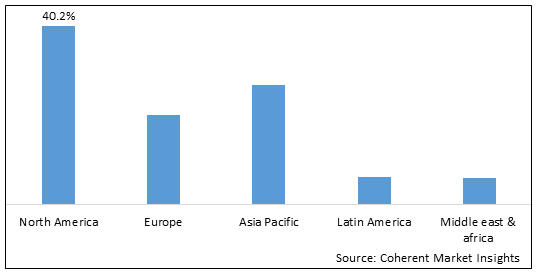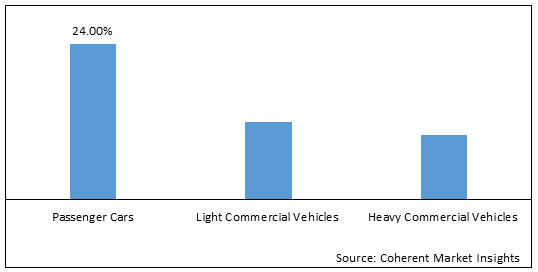Automotive Hydroformed Parts Market is estimated to be valued at USD 14.86 Bn in 2025 and is expected to reach USD 24.49 Bn in 2032, exhibiting a compound annual growth rate (CAGR) of 7.4% from 2025 to 2032.
Hydroforming is a metal fabricating and forming process which allows the shaping of metals such as steel, stainless steel, copper, aluminum, and brass. This process is a cost-effective and specialized type of die molding that utilizes highly pressurized fluid to form metal. Hydroforming is one of the most advanced forming techniques used in the automotive industry.
Rise in stringent government rules regarding emission, rise in demand for light weight vehicle, and a rise in vehicle production is expected to drive the growth of the market.
However, a rise in the usage of composite materials and high initial capital investments can hamper the growth of the market. Moreover, the rise in sales of electric and hybrid vehicles, rise in complex automotive parts, and rise in better & durable automotive parts act as an opportunity for growth of automotive hydroformed parts market.
Global Automotive Hydroformed Parts Market- Regional Insights
Global automotive hydro formed parts market is segmented into North America, Europe, Asia Pacific, Latin America and the Middle East & Africa.
North America is expected to account for the largest share of the global automotive hydro formed parts market due to the presence of a large number of automotive manufacturers in the region. The U.S. is the largest market for automotive hydro formed parts in North America, followed by Canada and Mexico. North America has been a prominent market for automotive hydro formed parts. The presence of major automobile manufacturers and their focus on light-weighting vehicles has driven the demand for hydro formed parts. The region has witnessed the adoption of hydro formed components in various vehicles, including passenger cars, SUVs, and light trucks.
Figure 1. Global Automotive Hydroformed Parts Market Share (%), By Region, 2025

To learn more about this report, Download Free Sample
Global Automotive Hydroformed Parts Market-Impact of Coronavirus (COVID-19) Pandemic
Due to COVID-19 pandemic government across all the major countries have announced lockdown and various other strict regulations. The pandemic has led to shutdown of manufacturing units in the automobile sector thus disrupting the demand for hydroformed parts. Also, due to the pandemic the demand for vehicles has fallen since lowering of people’s disposable income which further affected the automotive hydroformed parts market. Moreover, since the outbreak, curfews have been imposed in almost every country, wherein only a few authorized individuals are allowed to travel, resulting in further decline in the sale of automobiles. In addition, social distancing norms and other restrictions has led to unavailability of labour which delayed the manufacturing process. Also, due to the lockdown supply was affected since, there was unavailability of raw materials required for manufacturing of hydroformed parts. Thus, COVID-19 pandemic had a negative effect on the growth of automotive hydroformed parts market.
Global Automotive Hydroformed Parts Market– Drivers
Growing trend of miniaturization
The automotive industry is also seeing a trend towards miniaturization, as manufacturers are looking to create more compact and fuel-efficient vehicles. Hydroformed parts can be used to create complex and intricate shapes that would be difficult or impossible to produce using traditional methods.
For Instance, the Chevrolet Corvette Stingray uses a hydroformed aluminium chassis. The hydroformed chassis is lighter and stiffer than the previous steel chassis, which improves handling and performance.
Rise in Vehicle Production
The global automotive industry continues to experience steady growth, with increasing vehicle production across different regions. As the demand for automobiles rises, so does the demand for efficient manufacturing processes and lightweight components. This growth in vehicle production is driving the demand for hydro formed parts in the automotive sector.
Increasing demand for light weight vehicles
One of the main trends in the automotive industry is the increasing demand for lightweight vehicles. This is being driven by stricter emissions regulations, as well as the need to improve fuel economy. Hydroforming is an ideal technology for manufacturing lightweight parts, as it allows for complex shapes to be created with minimal material waste. This is especially important for electric vehicles, which need to be as lightweight as possible to maximize range. For Instance, Ford F-150 uses a hydroformed structural cage in its pick-up trucks. The strucutural cage is made of high strength steel and is hydroformed to create a single unit. This eliminates the need for welding, which reduces weight and improves strength.
Automotive Hydroformed Parts Market Report Coverage
| Report Coverage | Details | ||
|---|---|---|---|
| Base Year: | 2024 | Market Size in 2025: | USD 14.86 Bn |
| Historical Data for: | 2020 To 2024 | Forecast Period: | 2025 To 2032 |
| Forecast Period 2025 to 2032 CAGR: | 7.4% | 2032 Value Projection: | USD 24.49 Bn |
| Geographies covered: |
|
||
| Segments covered: |
|
||
| Companies covered: |
Alf Engineering, F-TECH, Magna International, Metalsa, Nissin Kogyo, Sango Co., Ltd., Tata Precision Tubes, Tenneco, Thyssenkrupp AG, Vari-Form, and Yorozu. |
||
| Growth Drivers: |
|
||
| Restraints & Challenges: |
|
||
Uncover macros and micros vetted on 75+ parameters: Get instant access to report
Global Automotive Hydroformed Parts Market– Opportunities
Advanced Driver Assistance Systems (ADAS)
The integration of ADAS technologies in vehicles is rapidly expanding. ADAS requires precise and reliable mounting systems for sensors, cameras, and other components. Hydroformed parts can provide the necessary structural support and mounting solutions for these advanced systems. There is an opportunity for hydroformed parts manufacturers to develop specialized components that meet the specific requirements of ADAS integration.
Growing Adoption Of Electric Vehicles
With the growing adoption of electric vehicles (EVs), there is an increasing need for EV charging infrastructure. Hydroformed parts can be used to manufacture components such as charging station housings, mounting brackets, and cable management systems. Manufacturers can leverage this opportunity by providing hydroformed parts that contribute to the durability, functionality, and aesthetic appeal of EV charging stations.
Global Automotive Hydroformed Parts Market– Trends
Increasing Light Weight Vehicles
Automotive manufacturers are continually striving to reduce the weight of vehicles to improve fuel efficiency and reduce emissions. By utilizing hydroforming techniques, automakers can create complex, lightweight components that maintain structural integrity while reducing overall weight.
Global Automotive Hydroformed Parts Market– Restraints
Lack of Standardization
The lack of standardized design guidelines and manufacturing processes for hydroformed parts can pose challenges. Each hydroforming project requires careful consideration of material selection, tooling design, and process parameters, which can vary from one manufacturer to another. This lack of standardization can increase lead times, costs, and potential quality inconsistencies.
Manufacturing Complexity and Cycle Time
Hydroforming involves multiple steps and processes, including tube cutting, bending, pre-forming, hydroforming, and post-processing. This complexity can lead to longer manufacturing cycle times compared to simpler manufacturing techniques. In high-volume production environments, longer cycle times can affect overall production efficiency and may not be compatible with tight production schedules.
Figure 2. Global Automotive Hydroformed Parts Market Share (%), By Vehicle Type , 2025

To learn more about this report, Download Free Sample
Global Automotive Hydroformed Parts Market- Segmentation
Global Automotive Hydroformed Parts Market report is segmented into Type, Material Type, Vehicle Type and Region.
Based on Type, the market is segmented into Tube Hydroforming, Sheet Hydroforming.
Based on Material Type, the market is segmented into Aluminium, Brass, Copper, Stainless Steel, Others.
Based on Vehicle Type, the market is segmented into Passenger Cars, Light Commercial Vehicles Heavy Commercial Vehicles.
Based on Region, the market is segmented into North America, Europe, Asia Pacific, Latin America, Middle East and Africa.
Based on Vehicle Type, Passenger car dominates the market, hydroformed parts are used extensively in passenger cars due to the increased demand for lightweight vehicles. Hydroformed aluminum and steel parts are commonly used in the construction of passenger car body panels, suspension components, and fuel tanks.
Global Automotive Hydroformed Parts Market: Key Developments
In March 2023, Magna International, Canadian parts manufacturer for automakers, announced that it had acquired Hydroforming Solutions, a leading provider of hydroforming technology for the automotive industry. The acquisition will help Magna to expand its hydroforming capabilities and meet the growing demand for lightweight vehicles.
In February 2023, Tenneco, automotive components original equipment manufacturer and an aftermarket ride control and emissions products manufacturer, announced that it had launched a new line of hydroformed exhaust components for passenger cars and light commercial vehicles. The new components are designed to be lighter and more durable than traditional exhaust components, which will help to improve fuel efficiency and reduce emissions.
In May 2023, Busyu Kogyo, manufacturer of motor vehicle parts and accessories announced that it had developed a new hydroforming process that can produce parts with complex shapes, The new process uses a combination hydroforming and laser cutting to produce parts with high accuracy and repeatability.
In April 2023, Magna International, Canadian parts manufacturer for automakers announced that it had opened a new hydroforming plant in mexico, the plant is located in Saltillo, Mexico, and will produce hydroformed parts for a variety of automotive applications.
Global Automotive Hydroformed Parts Market: Key Companies Insights
Key players operating in the Global Automotive Hydroformed Parts Market are Alf Engineering, F-TECH, Magna International, Metalsa, Nissin Kogyo, Sango Co., Ltd., Tata Precision Tubes, Tenneco, Thyssenkrupp AG, Vari-Form, and Yorozu.
*Definition: Automotive hydro formed parts refer to components of a vehicle that are manufactured using the hydroforming process. Hydroforming is a metal-forming technique that involves using a high-pressure fluid to shape and form metal into complex shapes and configurations.
Share
Share
About Author
Gautam Mahajan is a Research Consultant with 5+ years of experience in market research and consulting. He excels in analyzing market engineering, market trends, competitive landscapes, and technological developments. He specializes in both primary and secondary research, as well as strategic consulting across diverse sectors.
Missing comfort of reading report in your local language? Find your preferred language :
Transform your Strategy with Exclusive Trending Reports :
Frequently Asked Questions
Select a License Type
Joining thousands of companies around the world committed to making the Excellent Business Solutions.
View All Our Clients